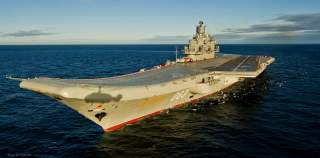The 2 Big Reasons Why Russia's Only Aircraft Carrier is Having So Many Problems
It is the quality of training and the soundness of its procedures that make a carrier work--and Moscow is very much behind.
The Russian Navy has lost two carrier-based fighters onboard its sole remaining carrier Admiral Kuznetsov in the span of only a few weeks. On both occasions, technical problems with Kuznetsov’s arresting gear played a central role in the accidents—which have cost the Kremlin a Mikoyan MiG-29KUBR Fulcrum-D and a Sukhoi Su-33 Flanker-D. While Kuznetsov’s hardware is old, the bigger issue is Russia’s relative lack of experience in naval aviation and insufficient proficiency with launching and recovering combat aircraft onboard a carrier at sea.
In the case of the first crash on Nov.14—where a MiG-29KUBR ran out of fuel and crashed into the Mediterranean—the aircraft was orbiting while deck crews attempted to fix a broken arresting cable that had become entangled with one or the three remaining wires. The cable had snapped when another MiG-29KR had landed safely onboard Kuznetsov—however, that aircraft had caught the fourth and last cable on deck. Meanwhile, the second crash on Dec. 5—this time involving a Su-33 Flanker—was also due to a snapped arresting gear cable.
Naval aviation is an inherently dangerous business, but many of Russia’s naval aviation mishaps are due to a lack of experience and proficiency in carrier-based operations. While some of the Russian Navy’s problems can be attributed to the elderly Kuznetsov’s many inherent flaws, the Russians have not developed the proper procedures or practices to operate carrier-borne aircraft safely at sea.
Kuznetsov—commissioned on Dec. 25, 1990—is an older ship, but the vessel’s age is not the real issue. There are a good number of U.S. Navy carriers that are far older than Kuznetsov that operate perfectly well. Nimitz, Dwight D. Eisenhower, Carl Vinson, Theodore Roosevelt and Abraham Lincoln—are all older than the Russian ship. Moreover, USS Enterprise (CVN-65)—which was retired on Dec. 1, 2012, after more than 50 years in service—was just as ready to launch and recover aircraft on the day she was pulled out of service as she was the day she was first deployed in 1962.
The reason the U.S. Navy can operate a carrier for more than half a century is because the service maintains the material condition of its ships and has superbly trained crews. The Russians—especially over the past 25 years since the collapse of the Soviet Union—have not always properly maintained Kuznetsov. Nor has Kuznetsov’s crew been given enough of a chance to gain the requisite proficiency to safely conduct carrier operations at sea.
Cables break—it happens even onboard the U.S. Navy’s fleet of supercarriers. Indeed, one particular incident I recall was when an old acquaintance of mine was nearly killed when a cable snapped onboard USS Kitty Hawk (CV-63) in 2005. His Boeing F/A-18F Super Hornet fell into the water and the ship nearly ran him and his weapons systems officer over. Meanwhile, there was chaos onboard Kitty Hawk as the ends of the cable thrashed across the flight deck—damaging aircraft and injuring crew members. Accidents happen—but a broken cable leading to a mishap is exceedingly rare onboard U.S. Navy carriers. Two accidents in less than three weeks is indicative of serious problems onboard.
“Cables separate/break at some interval—and that's big news usually leading to injury, death or mishap. The cable system breaking does happen regularly and they usually just remove it and work with less wires—two or three now with the new design,” one senior naval aviator told me. “The bottom line is that it's very rare, sometimes preventable (settings, maintenance, etc.) and it’s big news when it happens.”
Meanwhile, the earlier loss of the MiG-29KUBR is indicative of poor decision making on the part of the Russian commander—who should probably have diverted the jet to a shore base in Syria. U.S. Navy carriers—when operating close to shore—will designate divert airfields in case there is a serious emergency where the ship cannot recover its aircraft. Indeed, the carrier usually launches recovery tankers—aerial-refueling-configured Super Hornets—to ensure that jets have enough fuel to operate safely. While Kuznetsov does not have the ability to launch a tanker—or even buddy-refueller configured fighters—the Russians should have designated a divert field for emergencies.
“When the carrier and air wing team first put to sea they are considered to be in divert ops until they pass their Combat Operations Efficiency (COE) evaluation, which is also called ‘blue water certification.’ We also use divert ops if there is an engineering casualty on the carrier, for example if we’re only using one reactor… whether by necessity or by choice,” another senior U.S. naval aviator told me. “Typically, a ship-based limitation that could put the recovery of fixed-wing aircraft at risk leads to a divert ops situation, so we’d need to be in relatively close proximity to land—say, 200 nautical miles or so.”
As a force designed to project American power across the globe, the U.S. Navy has designed its procedures to enable safe carrier operations even in the middle of the ocean—far from any land bases. “Blue water ops enable the carrier and air wing to conduct flight operations anywhere, anytime,” the second naval aviator said. “We utilize tankers to provide the required gas — ‘front side’ gas to give us more to train with, with ‘back side’ gas available as required when an aircraft’s fuel state gets low.”
Ultimately, it is not the age of its ships or the capabilities of its hardware that makes the U.S. Navy the globe-spanning titan that it is. It is the quality of its training and the soundness of its procedures that make the service what it is. Russia has long way to go before it ever comes close to matching American naval aviation prowess.
Dave Majumdar is the defense editor for The National Interest. You can follow him on Twitter: @davemajumdar.
Image Credit: Creative Commons Flickr.

